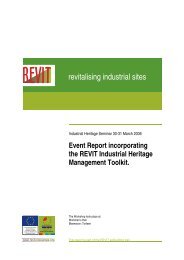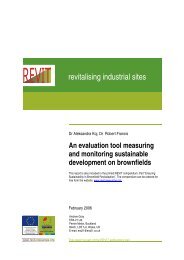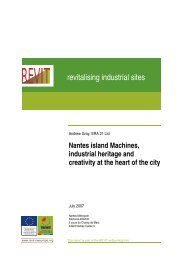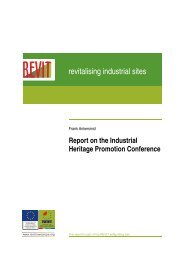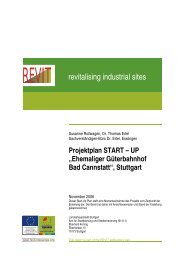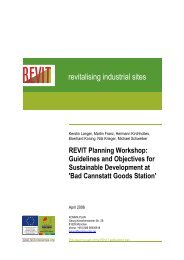REVIT Heritage Report.pdf
REVIT Heritage Report.pdf
REVIT Heritage Report.pdf
Create successful ePaper yourself
Turn your PDF publications into a flip-book with our unique Google optimized e-Paper software.
Torfaen County Borough Council<br />
<strong>REVIT</strong>: A Review of the Conservation of Industrial <strong>Heritage</strong> Assets on Brownfield Sites<br />
2 Linking Industrial <strong>Heritage</strong> and Regeneration<br />
2.1 Cultural <strong>Heritage</strong> and Sustainable Development<br />
2.1.1 The European <strong>Heritage</strong> Conservation Year 1975 was a defining point in<br />
Europe’s change of attitude toward the historic landscape and a more<br />
questioning approach to unsustainable growth. In some countries of the<br />
European Union, large numbers of historic, and therefore architectural and<br />
archaeological sites, have been destroyed in the course of urban revival,<br />
economic expansion and road construction in the post-war period up to the<br />
1970s.<br />
2.1.2 The growth of heritage-led regeneration protection has frequently caused the<br />
reconsideration of urban renewal and state development policies as a whole.<br />
It has also led to more sustainable policies for the regeneration of historic<br />
landscapes to be adopted.<br />
2.1.3 As a result the conservation and protection of cultural heritage is no longer<br />
considered to be an obstacle, but the driving force of urban development; the<br />
source of attractiveness of towns and cities and a landscape’s uniqueness.<br />
New laws, administrative measures, state funding programmes and tax relief<br />
polices were instituted to promote sustainable conservation and protection of<br />
cultural heritage remains across the European Union and also to highlight the<br />
importance of conservation and protection of the cultural heritage.<br />
2.1.4 This trend matured and flourished in the 1980s, preserving historic the layout<br />
of towns and cities, carefully renewing the fabric of old buildings, integrating<br />
important architectural heritage sites, making use of growth potential in order<br />
to revive old buildings which are the basis of this policy of sustainable<br />
development.<br />
2.1.5 Over 100 years the decline and redundancy of large-scale manufacturing and<br />
mining industries in the great economies of Western Europe has left a gap in<br />
employment and land-use which is ripe for regeneration. At the same time the<br />
benefits were appreciated of preserving and conserving our cultural heritage in<br />
terms of the economic benefits, lifestyle and re-use of existing buildings<br />
against re-development.<br />
2.1.6 The definition of industrial heritage must be considered as broad as possible<br />
and encompass important features such as buildings, bridges, viaducts,<br />
aqueducts, leats, balance ponds, parks, landscapes, museums, archives,<br />
townscapes, waterways and archaeology, whether of local or national<br />
importance, as well as intangible heritage such as language or oral traditions.<br />
The emphasise has to be the need to deliver benefits to people as well as to<br />
places and deliver not just conservation, but greater access and involvement<br />
for communities and new economically sustainable uses for historic places.<br />
2.1.7 Historic places, buildings, landscapes or townscapes, are part of a wider<br />
heritage and people often relate strongly to the places where they live or were<br />
brought up. Historic buildings or features contribute to the distinctiveness and<br />
identity of places, and can be a source of history and meaning for people.<br />
<strong>Heritage</strong> adds depth, character and value to places. Individual owners may<br />
bear the cost of caring for a historic place, but the benefits accrue to the wider<br />
community. This is why there is often a case for subsidy or regulation to<br />
correct a failure of the market.<br />
0014021/JM/001 3




